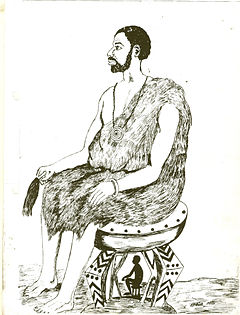| Mwene Mbandu I Lyondthzi Kapova | |||||
|---|---|---|---|---|---|
| 21st King of the Mbunda people | |||||
 Seated on his throne endowed in Mbunda Royal Insignia:
Missing Mbunda Royal Insignia on the image:
| |||||
| Reign | 1800s - 1914 | ||||
| Predecessor | Mwene Katavola II Musangu | ||||
| Successor | Mwene Kathzungo Shanda | ||||
| Born | Lyondthzi 1800s | ||||
| Died | 1914 Unknown (Abducted by Portuguese colonialists) | ||||
| Burial | ? ? | ||||
| Issue | Prince Mumbamba Lyondthzi, Prince Limbwambwa Kalyangu Lyondthzi, Prince Kalimbwe Lyondthzi, Prince Kameya Muyeji Lyondthzi | ||||
| |||||
| Mbunda | Mbandu | ||||
| House | Kalyamba located in the valley of Lunjweva and Lwati rivers | ||||
| Dynasty | Mbandu | ||||
| Mother | Vamwene Vukolo Ngimbu Kanchungwa | ||||
King Mwene Mbandu I Lyondthzi Kapova was the 21st monarch of the Mbunda people in the southeast of present-day Angola before the Portuguese colonization of the Mbunda territory at the beginning of the 20th century, specifically Moxico.[citation needed] The prince played a significant role in the war against the Chokwe.[citation needed] He took over the Mbunda Kingdom from his nephew King Mwene Katavola II Musangu.[citation needed]
Prince (Munamwene) Mbandu Lyondthzi Kapova was the son of Vamwene Vukolo Ngimbu Kanchungwa, one of the daughters of Vamwene Ngambo Lyambayi.[citation needed]